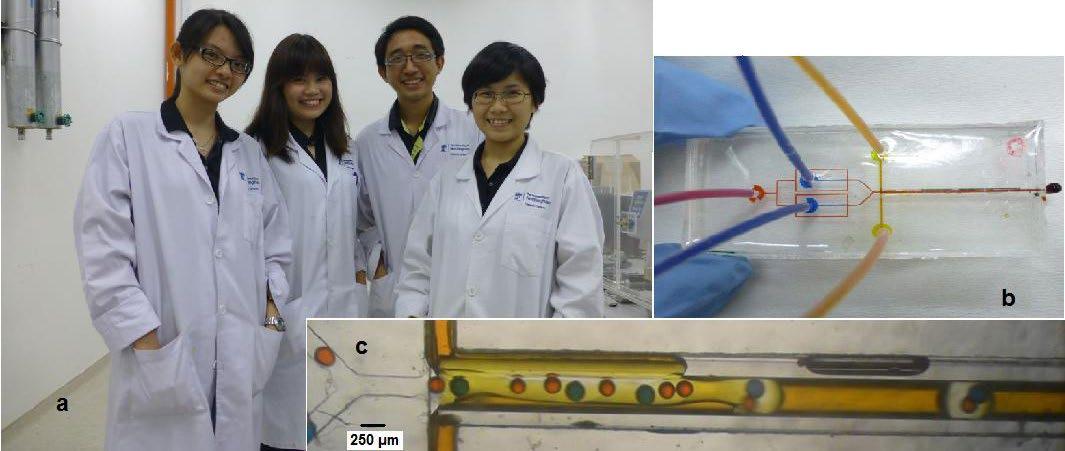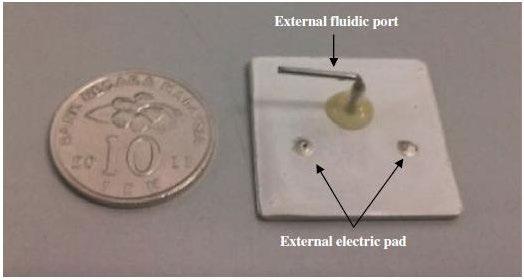
7 minute read
Microfluidic technologies
by Dr. Jitkai Chin (University of Nottingham Malaysia Campus, UNMC) & Tengku Farah Wahida Ku Chik (National Space Agency Malaysia, ANGKASA)
Advertisement
Introduction
Micro$uidic technology has attracted attention of researchers from chemistry and biomedical sciences since its early development with the aim of limiting resource usage and waste reduction. By modifying the micro$uidic devices and pulling in new technologies, the device could potentially transform future space exploration missions to be safer, more reliable and sustainable.
In manned missions, lab-on-chips could be used for health monitoring for astronauts, and may produce medicines in unfortunate cases. For outer space missions, chemical liquid propellant micropropulsion systems could drive satellites or mini-space probes. In the future, it may also be a signi!cant part of space landers, revealing geological mystery on asteroids or comets unknown to us thus far.
Although manned missions may still be limited to International Space Station (ISS) and the moon for the next two decades, unmanned missions such as mining valuable resources may be common. Collecting and returning samples from an asteroid has been completed by Japan Aerospace Exploration Agency (JAXA) [1] while the ROSETTA mission is expected to land and study Comet 67P/Churyumov-Gerasimenko by the end of this year [2]. New innovative technologies are continuously explored and pulled in to ensure success in space explorations. One of the key fundamental technologies useful in future space and planetary exploration is micro$uidics, a key branch of miniaturisation technologies, which may be useful in a variety of systems of space vehicles or probes.
"e concept of micro$uidics was introduced about two decades ago with active research that only begun by late 1990s. It refers to creeping $ow in microchannels ranges 50 – 500 microns in width and 20 – 75 microns in channel’s depth. Absence of turbulence is a double-edge sword as the $ow is predictable and easy to manipulate but it also essentially means external force is required to enhance mixing. Droplet micro$uidics hence becomes an ideal alternative as it provides absolute spatial and temporal species control. In some cases, the interfaces can even act as a control mechanism for chemical reaction [3].
Micro#uidics in Space Exploration
In recent years, successful biomedical testings and integrations with electronics parts have led to the development of Lab-on-chip. It means that lengthy
Figure 1: (a) Undergraduate research students who worked on double-emulsion in microfluidics. From left: Lim Chang Nong, Tan Xinyi, Jared Chong Sh’ng Yuan and Lee Pay Herng. (b) Microfluidic device for double-emulsion. Red input is the silicone oil while Blue and yellow streams are distilled water with dyes respectively. (c) Blue and red droplets of different sizes encapsulated in flow segments.

Figure 2: Sequence of pictures showing mother droplets merged at the Two-planar Y-junction before forced to split by the channel geometry. Droplets approaching the two-planar Y-junction at very low velocity (a & b). Two droplets merged at the Y-junction (c), and then forced to split (d).
and laborious process of sample preparation, manipulation, detection and analysis are not only successfully squeezed into a piece of micro$uidic device within a hand palm, but also reduces standing time from hours to seconds.
"ese unique operational characteristics resulting in the Lab-on-chip becoming an ideal diagnostic device for astronauts, who are normally based in ISS for a duration of minimum 5 months with limited supplies from the ground. "ese devices are not only expected for health monitoring purpose but also, in the future, will be able to manufacture medicines for sick astronauts, through emulsion or nano-sized particles, which have been successfully demonstrated on ground.
As more unmanned landing missions on planets or asteroids are planned for the next decades, it is not surprising to see the potential of micro$uidic technologies being further modi!ed to suit in those automated machines to carry out in situ analysis. For example, micro$uidic devices will be integrated into ExoMars rover seeking for biosignature of Martian life.
However, there are still tonnes of technical challenges ahead. For example, extracting biomarkers, organic compounds or morphology from fossils or organic-rich shales is the key step but solid handling of micro$uidic devices still remains a signi!cant challenge in which integration with other separation component seems unavoidable. Most asteroids or planet surfaces are notorious for violent and unpredictable weather.
Polymeric micro$uidic devices are not only susceptible to huge temperature cycles that vary by hundred degrees on the planet surface but also other extreme cases such as thundering, acid clouds and sand storms. Assuming that the devices are enclosed as a component in an analytical system that can survive cosmic rays, tiny particle such as sand or dust is a giant killer for any micro$uidic device as it may completely block a single channel and causing the unit to completely malfunction, leading to major disaster or mission failure. In addition, whether the device can sustain years of space travel and survive bumpy landing process remains an enigma.
Our Research
Various micro$uidic research works are being carried out in our laboratory using microfluidic devices fabricated with modi!ed soft lithography method using polydimethylsiloxane (PDMS) and other composite materials. One of the focus areas is droplet micro$uidics. In a previous study, we concluded that formation of immiscible liquid-liquid droplet at low Weber Number was dominated by hydrodynamic force.
On the other hand, shear force plays a signi!cant role in droplet formation at high Weber Number due to increase in surface area as the disperse phase extruding into the main channel continuous phase. "e !ndings lay down the foundation for droplet micro$uidic research in our laboratory. For example, undergraduate research students successfully design and quantify double-emulsion in a micro$uidic device, as shown in Figure 1.
Our recent work focuses on parallel splitting of liquid droplet via multi-layer-junction microchannel con!guration. With proper channel geometry and microchannel configuration design (Figure 2), asymmetrical droplets can be consistently generated

Figure 3: A zirconia-based ceramic micropropulsion system developed by our research group, compared with a Malaysia’s 10-cent coin.
from each single nano-litre mother droplet. It enables parallel chemical detections carried out simultaneously on the same device. Furthermore, asymmetrical droplets enable custom detection to be carried out. For example, if a particular enzyme or nutrient detection requires only very tiny sample volume, small droplets can be utilised for this purpose; while larger droplets can be directed for other purposes of detection, hence ensuring high e%ciency of sample utilisation.
By integrating the concept of micro$uidic into a propulsion system for small satellites, our research group is developing a liquid chemical-based micropropulsion system, which is the ‘heart’ for next generation extremely small satellites such as microsatellite, pico-satellite or Cubesat, poised to replace some satellites currently servicing Near Earth Orbits (NEOs) or altitude control for larger space-probes.
The basic design of the micropropulsion design consisted of a reservoir for temporary storage of the liquid propellant, a transport microchannel that connects the reservoir and a combustion chamber, where chemical reaction takes place (Figure 3). "e post-combustion hot gas products are dispensed to ambient environment at high speed via a carefully designed nozzle, hence generating thrust in opposite direction. Similar effort also being carried out in NASA to develop Microfluidic Electrospray Propulsion (MEP) utilizing capillary force to feed indium propellant into reaction chamber.
"ere are a number of noticeable similarities between these systems with conventional microfluidics: extremely small $ow-rate and the performance are highly dependent on the $ow pro!les throughout the systems.
However, polymer is not a good candidate as structural material for the micropropulsion system because of high chamber temperature that always beyond the melting points and degassing caused by cosmic rays. By using gel casting of homogeneously dispersed zirconia suspension on PDMS soft mold, microthruster geometries were successfully replicated into a ceramic layer of 1.2 mm [4].
We are convinced that utility of microfluidics technology in future space exploration shall not be limited by the examples given. "ere are other potential applications such as capturing and returning cosmic dust to Earth, rapid diagnostic devices in !rstaid-box, and culture medium for crops during space travel. We believe that micro$uidics will transform space exploration in the near future.
REFERENCES
[ 1] Hayabusa Press Kit (2010). JAXA www.jaxa.jp/ projects/sat/muses_c/img/presskit_hayabusa_e.pdf [2] Glassmeier, K-.H. et al. (2007). Space Science Reviews, 128:1–21. [3] Atencia, J. & Beebe, D. J. (2005). Nature, 437: 648–655. [4] Cheah, K. H., Khiew, P. S. & Chin, J. K. (2012). Journal of Micromechanics and Microengineering, 22:095013.
ABOUT THE AUTHORS
DR. JITKAI CHIN graduated with BEng from Department of Chemical and Process Engineering, University of She%eld UK in 2001. He then obtained his PhD in Micro$uidics from the same department. He joined Department of Chemical and Environmental Engineering, UNMC since 2007. He is an Associate Professor whose current research interest including droplet micro$uidics, micropropulsion system and energetic materials. Find out more about Dr. Chin by visiting his Scienti!c Malaysian pro!le at http://www. scienti!cmalaysian.com/members/jitkaichin/
MRS. TENGKU FARAH WAHIDA KU CHIK
received her MSc from "e University of Malaya in 2008. She is currently a research o%cer in Propulsion Unit, National Space Agency Malaysia (ANGKASA), under Ministry of Science, Technology and Innovation (MOSTI). Mrs. Tengku Farah can be reached via email at farahida@angkasa.gov.my










